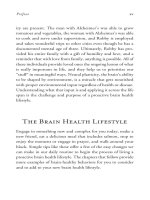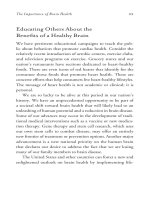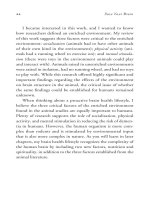Save Your Brain: The 5 Things You Must Do to Keep Your Mind Young and Sharp_6 pptx
Bạn đang xem bản rút gọn của tài liệu. Xem và tải ngay bản đầy đủ của tài liệu tại đây (224.03 KB, 15 trang )
Adopting a Healthy Brain Lifestyle 59
healthy choices.” You can become a champion of a proactive
brain health lifestyle and actually serve as a role model to others,
particularly your children and grandchildren.
We already know about several basic preventative measures
to take every day for brain health, like wearing a helmet when
riding a bike, wearing a seatbelt when in the car, and being
cautious with activities that have the potential to cause head
injuries. But, in addition to these safety tips, research shows
that brain health is promoted by a lifestyle that includes stress
reduction, consumption of antioxidants and omega-3 fatty
acids, physical exercise, socialization, and exposure to enriched
environments with the novel and complex. A conscious choice
to review your current lifestyle and begin implementing change
within each of these fi ve domains to the brain health lifestyle is
critical. Additionally, lifestyle is proactive, energized, and life-
long. A lifestyle that promotes health will be effective at any
age, but the earlier you get started, the better the outcome. Your
goal should be to make the brain health lifestyle a routine in
your life.
Adoption of a brain-healthy lifestyle can occur on an indi-
vidual basis and on a more macro or societal basis. The indi-
vidual basis is probably most important and most effi cient, as
you have direct control over the change. However, every nation
should consider prioritizing brain health and implement poli-
cies that reinforce this priority. Now let’s take a closer look at
the fi ve critical areas for brain health and what you can do to
keep your brain young, fi t, and sharp!
This page intentionally left blank
61
4
The Five Critical
Areas of
Brain Health
I have a wonderful opportunity to care for and
to shape my brain for health.
7
Y
our brain is a highly dynamic and constantly reorganiz-
ing system capable of being shaped across your entire life
span. Similar to animals, the human brain can generate new
brain cells and respond to environmental input. Your goal is to
expose your brain to enriched environments, to the novel and
complex, and to grow your brain reserve!
As we discussed in the previous chapter, stimuli that are
considered rote and passive to your brain are most likely not as
health promoting. We learned from animal brain research that
an enriched environment has three critical components: social-
ization, physical activity, and mental stimulation. It makes per-
fect sense to consider these same critical factors as important
Save Your Brain62
to the human brain, especially in light of research on humans
suggesting their role in staving off the ravages of Alzheimer’s.
In addition to these three factors, I have included two new
ones that are critical to promotion of brain health. The fi rst is
spirituality, which refl ects the importance of reducing stress in
our lives, slowing down, and appreciating the moment. The
second is nutrition, which respects the fact that what we eat
literally changes the physical and functional aspects of our body
and relates directly to our overall health, including brain health.
Each of these fi ve factors of my brain health lifestyle is backed
up by robust research to support its effectiveness. Most impor-
tant, the lifestyle needs to be integrated, comprehensive, and
proactive to be most effective for health and brain health. To
recap, I have proposed a lifestyle that includes the following fi ve
areas critical to brain health:
• Socialization
• Physical activity
• Mental stimulation
• Spirituality
• Nutrition
Each of these factors is necessary to your brain health life-
style,
and together they form an integrated whole for you. The
fi ve factors need to be understood as one lifestyle and not sepa-
rate entities. Remember, your goal is to adopt a proactive life-
style for brain health that increases your brain reserve through
exposure to the complex and novel. As with any lifestyle pro-
gram, the journey can be challenging, but your brain health
The Five Critical Areas of Brain Health 63
lifestyle is a lifelong journey toward wholeness and will require
constant personal review and change. While adopting to any
lifestyle change is not easy, the goal of a healthier and more
challenged brain is worthwhile.
Research-Based Approach:
Identifying the Five
Critical Areas
My healthy brain program is research-based, easily under-
stood, and practical, as anyone can consider making changes to
incorporate these activities into their own daily life. The other
positive aspect of my lifestyle is that anyone can assess each of
the fi ve different lifestyle domains and understand which is a
strength and which is a weakness, thereby providing a guide as
to where the biggest change in behavior may need to occur. My
program rests on the cognitive construct of brain reserve and
the belief that neural plasticity affords the brain a wonderful
opportunity to achieve health.
While my brain health lifestyle is developed from a sound
understanding of brain and behavior, cognitive science, and
clinical research, I realize that a practical way to apply the life-
style is in many ways most critical—you’ll fi nd all of the practi-
cal strategies to implement this lifestyle in the chapters ahead.
The brain health program that I offer you is unique in that
it is lifestyle-based, comprehensive, and integrates many differ-
Save Your Brain64
ent research fi ndings into one practical approach that is easy
to adopt. My brain health lifestyle was applied recently as part
of a small pilot investigation with healthy independent older
adults. This work was done together with Emeritus Assisted
Living (www.Emeritus.com) at a campus in the Boston region.
I believe we were the fi rst to launch a prospective lifestyle study
on brain health (Dr. Nussbaum’s Brain Health Lifestyle) and
the fi rst to propose a lifestyle that was comprehensive (includ-
ing all of the fi ve critical areas of brain health and not just
one).
Details of the Pilot Study
In 2008, we designed our fi rst prospective pilot study to measure
the effects of the brain health lifestyle on older independent-
living residents of Farm Pond at Emeritus Assisted Living.
Farm Pond was a wonderful setting to create a brain health
campus and to conduct the study. It is a self-contained campus
with three components to the continuum of care, including
independent living, assisted living, and memory-impaired liv-
ing. Our study focused on the independent-living residents.
The other important positive quality about Farm Pond is that
it had good leadership to make sure the study protocol was fol-
lowed properly.
Our goal for conducting this study was to fi nd answers to
the following questions:
The Five Critical Areas of Brain Health 65
• Does the brain health lifestyle help to enhance memory in
the form of verbal recall?
• Does the brain health lifestyle improve quality of life as
reported by the actual residents?
• Does the brain health lifestyle improve quality of life as
reported by an independent third party who worked at
Farm Pond?
• Did the residents know more about their brain and brain
health by the end of the study?
Sixteen volunteers were randomly selected from the
independent-living residents to participate in the brain health
lifestyle for six weeks. This group represented our experimental
sample, and they would follow a relatively strict protocol for
the entire six weeks of the study. An additional and separate ten
residents from independent living made up the control sample.
These persons were not part of the brain health lifestyle pro-
tocol, and they simply continued to live their lives as usual at
Farm Pond during the six weeks of the study. The residents in
the experiment group and the control sample were not signifi -
cantly different on variables of age, education, marital status, or
gender.
Each resident in both the control sample and experiment
group underwent a baseline assessment that included measures
of mental status, verbal recall with measures of immediate
and delayed recall and recognition memory, mood, and basic
knowledge of brain health. Each resident then underwent a
post-study assessment using the same measures. The same per-
son conducted the two assessments to provide some control
Save Your Brain66
on the actual assessment process, and different forms of the
memory tool were used to minimize practice effects. I devel-
oped a self-report and third-party report that gauged quality of
life and was completed by residents in the experimental sample
only at the post-study period.
As expected from prospective studies, four residents from
the experimental group and one resident from the control sam-
ple dropped out of the study prior to its conclusion. An analysis
of the data indicated that the four who dropped out had lower
mental status scores relative to those who remained in the study,
suggesting that cognition may have been a variable predicting
ability to sustain the six-week-long lifestyle. All residents were
determined to be free of dementia, depression or other neurop-
sychiatric illness, substance abuse, uncontrolled hypertension
or diabetes, and any uncorrected sensory defi cit. The samples
truly represented healthy, independent-living older adults.
Residents enrolled in the brain health lifestyle participated
in one research-based activity within each of four domains of
the lifestyle (physical activity, mental stimulation, spirituality,
socialization), and they also consumed a special brain health
diet. This occurred each day of the week for the entire six weeks.
Examples of some of the activities within the physical activity
domain included dance, walking, and aerobic exercise. Mental
stimulation included sign language, Portuguese, discussion of
the classics, and courses on the basics of the brain. Spirituality
included prayer, meditation, and relaxation procedures. Social-
ization included fi eld trips, recreational events, and games.
The Five Critical Areas of Brain Health 67
Results of the Pilot Study
People who enrolled in the brain health lifestyle program from
the experimental group demonstrated no signifi cant differences
on measures of mental status, mood, or level of knowledge on
the human brain at baseline relative to the control sample. How-
ever, changes in scores measured at post-study testing compared
to baseline revealed trends to signifi cance on measures of men-
tal status and memory. Most striking, when the data from the
experimental group was analyzed as a within-group measure,
signifi cant improvements were found on delayed recall and
knowledge of the brain. That is, residents who participated in
the six-week brain health lifestyle were able to recall presented
information after a twenty-minute delay period better than
they could prior to the start of the study. This is an important
fi nding and may be the fi rst to show a positive effect of a com-
prehensive lifestyle approach on enhanced memory.
Residents who participated in the brain health lifestyle dem-
onstrated the expected signifi cant improvement in self-reported
knowledge of the human brain and how to keep their brain
healthy. Quality of life was measured using a special tool devel-
oped by my questions dealing with a variety of aspects of one’s
life. Results indicate that the residents enrolled in the brain
health lifestyle program reported positive sentiments about
their life and mental and emotional functions after the study.
They also expressed their belief that the brain health lifestyle
was benefi cial to them. They further expressed the belief that
the brain health lifestyle is something that could be benefi cial to
everyone. Of equal interest were the results from the third-party
ratings of quality of life. A designated person was asked to rate
Save Your Brain68
the resident’s function, demeanor, social, and cognitive abili-
ties at the conclusion of the lifestyle program. Similar to the
self-report measures, the third-party ratings refl ected improved
overall function and quality of life for those who participated
in the lifestyle program.
There was no change between samples or within the experi-
mental sample on general mental status or mood. As no resi-
dent was found to be depressed upon entering the study, the
fi nding of no improvement in depression is not unexpected.
Regarding general mental status, the measure simply refl ects
basic information processing, and all residents who participated
in this study performed near the ceiling at baseline and did not
have room to improve by post-study.
Upon completion of the study, I met with the residents who
participated in the six-week lifestyle. Results were discussed, and
the residents provided important feedback about their experi-
ence. What we learned from the residents may have been more
important than the positive data on memory and quality of life.
Residents stated the lifestyle programming was “life changing”
and reported, “It saved me, as I was not living since the death of
my spouse,” and “It brought me to life again and helped me get
out of my room.” These testimonials provide strong support for
the power of the brain health lifestyle, and Farm Pond is now
working to extend the program to all residents in independent
living. Indeed, the original residents of the study agreed to be
the ambassadors and lead the program on their campus.
This pilot is a small study of a few residents, and results
need to be interpreted with caution. However, the fi nding of
improved delayed recall and positive ratings on quality of life
at the conclusion of the study are signifi cant and deserving of
The Five Critical Areas of Brain Health 69
attention. There is real reason to believe that a sustained and
proactive brain health lifestyle that is comprehensive and inte-
grated has potential to enhance cognitive functioning and qual-
ity of life in healthy older adults. There is also reason to believe
that such a lifestyle should have similar effects in younger and
middle-aged adults. With some modest alteration, the brain
health lifestyle can also be followed by those who may require
some assistance during the day, and even with those who have
mild dementia. These are empirical questions that can be
answered with more study and research. The pilot study is the
fi rst, albeit modest, empirical measure of the benefi ts one can
obtain from following a brain health lifestyle, an early glimpse
into the program’s potential.
This study is a step that takes us beyond practical applica-
tion of the brain health lifestyle to being able to cite empirical
measures for its value. The next step is to replicate these early
positive results with a larger and perhaps more diverse popula-
tion. Ultimately, the brain health lifestyle should be a part of
any prevention or wellness program, as the brain is the most
important part of our being! Let’s take a look at the fi ve critical
areas of brain health.
Five Critical Areas of
Brain Health: An Overview
The following provides a blueprint for the development of a
brain health environment fi lled with the novel and complex.
Save Your Brain70
The brain health lifestyle incorporates fi ve distinct but inte-
grated components: socialization, physical activity, mental
stimulation, spirituality, and nutrition. Each of these compo-
nents, or “slices to the brain health pie,” encompasses research-
based activities that have been documented to reduce the risk
of dementia or to foster brain health. Together, these activities
defi ne the brain health lifestyle, which can be effectively applied
in a culture committed to change.
Socialization
The fi rst critical area to think about in order to promote a
healthy brain lifestyle is the area of socialization. Research in
both animals and humans indicates socialization is important
to health and for reducing the risk of dementia. It is impor-
tant, therefore, to remain integrated in the community, to build
a growing network of family and friends, and to always have
a role and purpose for getting up each day. Retirement, as a
national policy, does not make sense for a nation that priori-
tizes brain health for its citizens. Retirement promotes isolation
and passivity, which reduces the likelihood of building brain
reserve and drives a brain toward disease. Socialization is so
vital to brain health that it will be the fi rst of the fi ve areas of
brain health we will explore at length in the following chapters.
However, I do not want to convey that one domain is more
important than the other.
The Five Critical Areas of Brain Health 71
Physical Activity
Physical activity relates to brain health because 25 percent of the
blood, oxygen, and glucose from each heartbeat goes directly to
the human brain. While the human brain weighs only two to
four pounds on average, it demands more from each heartbeat
than any other part of the body! It truly is the “central” ner-
vous system. Knowing this simple fact, you can better appreci-
ate why physical activity promotes brain health. The human
brain consumes such a high level of glucose, oxygen, and blood
because it cannot function without this energy source. Cells
thrive from such blood fl ow and metabolize glucose for brain
function, permitting rapid and effi cient information processing.
Even a brief period of slowed or no blood fl ow to a particular
region of the brain can result in structural damage in the form
of stroke, and this leads to loss of such functions as movement,
language, and even personality change. You will learn much
more about the crucial link between physical activity and brain
health in Chapter 6.
Mental Stimulation
We have learned that novel and complex environments help to
activate the cortex and conscious information processing that
promotes development of brain reserve. Our ability to engage
our brain daily in the novel and complex fosters mental stimu-
lation and promotes brain health. This includes new learning,
which actually involves a neurophysiological event or series of
events that change our neural systems, our neural chemistry,
Save Your Brain72
and our brain function. This process can also assist with new
brain cell development, or neurogenesis.
Animal studies have demonstrated neurogenesis in rodents
exposed to enriched environments that include novel and com-
plex stimuli. Human neurogenesis was demonstrated in a pub-
lication in 1998, with the neuroanatomical structure critical
to learning, the hippocampus, representing the site of neuro-
genesis in both animals and humans. This supports the idea
that the hippocampus and the role of learning are fundamen-
tal to our neural health and that our brains are agile and can
adapt favorably in response to healthy stimuli. Environments
that provide novel and complex stimuli are those most likely to
be deemed “enriched,” with the greatest likelihood of promot-
ing brain reserve. Brain reserve refers to the development of
increased cellular connections (synapses) that help to defend
against or delay the onset of neurodegenerative diseases such as
Alzheimer’s.
A critical issue for everyone to remember is that the most
sophisticated system for thinking, creating, problem solving,
and basic academics is the human brain. It is critical for our
society to turn inward for solving problems rather than relying
only on gadgets or devices to do the work! Chapter 7 provides
many specifi c ideas and suggestions for how you can enrich
your own environment with the novel and complex.
Spirituality
We all lead very busy lifestyles, and surely, like many others,
you feel the high stress of a fast-paced environment. It’s no
The Five Critical Areas of Brain Health 73
wonder we’re doing so much damage to our own health because
of it. This area, which I refer to as spirituality, addresses the
need for all of us to slow down, to introspect, and to reduce
stress in our lives. By engaging in a slower and more refl ective
life, we can impact our health and brains in a positive way.
Research indicates that animals exposed to environments
that are too stimulating experience slowed brain development.
Our own pace in life tends to be rapid and probably unhealthy.
While most of us realize that we are going too fast and that we
are involved in too many activities simultaneously, we have a
hard time knowing how to slow down.
The brain demands stimulation, but it also can function best
when it has rhythm and symmetry. Our hectic pace raises the
probability of mental chaos, stress, and reduced cognitive effi -
ciency. It also can lead to emotional breakdown. A brain health
environment supports time for oneself, time to slow down, and
time to keep the brain energized. I refer to this generally as
spirituality. Of interest is the fact that an entire new fi eld of
study called
neurotheology has emerged to study the relationship
between spirituality, religion, and the brain. You will read more
about neurotheology in Chapter 8 and also learn techniques for
relaxation and stress abatement.
Nutrition
Food has the ability to alter thought processes, mood, and
behavior. There is an entire new fi eld of study called
nutritional
neurosciences
that recognizes the impact of food on the function









